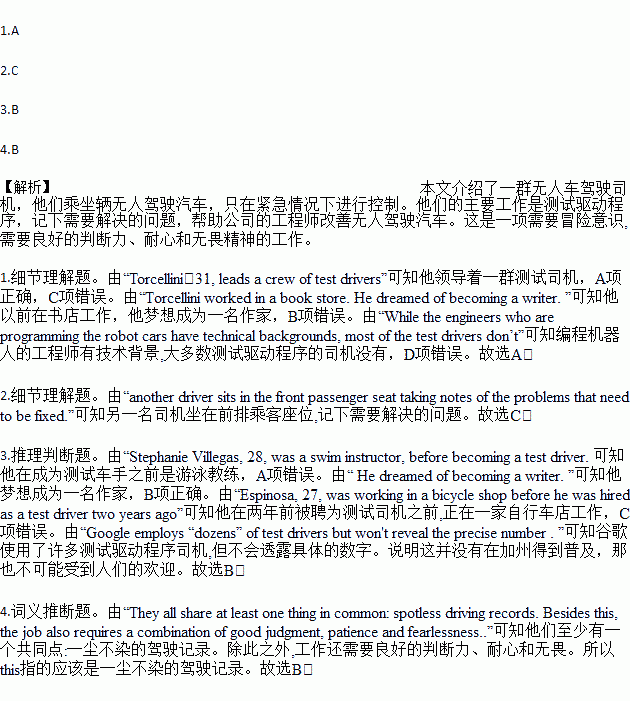题目内容
After a friend recommended that he join a secret Google project six years ago, Brian Torcellini became a driver in a driverless car.
Torcellini,31, leads a crew of test drivers who are legally required to ride in Google’s fleet of 48 driverless cars . They only take a control in emergencies. Otherwise, they make observations that help the company’s engineers improve the driverless cars.
The driverless cars already have covered more than 2 million miles in six years of testing on private tracks, on highways and city streets. The vehicles have traveled more than half that distance in automated mode (自动模式),with one test driver in place to take control of the car if the technology fails or a potentially dangerous situation arises. Meanwhile, another driver sits in the front passenger seat taking notes of the problems that need to be fixed.
The job of the test driver requires a sense of adventure, something Torcellini acquired when he began to surf in high school. His other hobbies include fishing and scuba diving.
While the engineers who are programming the robot cars have technical backgrounds, most of the test drivers don’t. Torcellini worked in a book store. He dreamed of becoming a writer. He ended up at Google in 2009. Espinosa, 27, was working in a bicycle shop before he was hired as a test driver two years ago . Stephanie Villegas, 28, was a swim instructor, before becoming a test driver. Other test drivers were former soldiers and former photographers. They all share at least one thing in common: spotless driving records. Besides this, the job also requires a combination of good judgment, patience and fearlessness.
Before they are entrusted (托付) with the cars,Google’s test drivers must complete three-week training courses. The drivers are taught to take control of the robot car whenever there is any moment of doubt or danger.
Google employs “dozens” of test drivers but won't reveal the precise number . California law requires two test drivers per vehicle.
1.What do you know about Brian Torcellini ?
A. He is in charge of a crew of test drivers.
B. He used to be a swim instructor.
C. He led a secret Google project.
D. He has technical backgrounds.
2.The driver sitting in the front passenger seat is responsible for .
A. fixing the car problems
B. driving in emergencies
C. recording the car problems
D. monitoring the car driver
3.We can infer that .
A. Stephanie Villegas is interested in scuba diving
B. Brian Torecellini is very fond of literature
C. Espinosa is an excellent cyclist in California
D. driverless cars are very popular in California
4.The underlined word “this” refers to .
A. having good judgments
B. having clean driving records
C. breaking the traffic rules
D. having technical backgrounds
 名校课堂系列答案
名校课堂系列答案----____( )
| A. | My pleasure | B. | Good heavens | ||
| C. | Thanks a lot | D. | The same to you. |
We all know that some things are obviously right.For example,it is right to be (1)kind to other people.It is also right to look after the environment.Some things are (2)eleralywrong,too.For instance,we should not hurt or bully(欺负) others,nor should we litter.Rules often tell us what is right or wrong..
Rules can help the public make the right (3)choices,and remain safe.Car drivers have to obey traffic regulations that tell them the right things to do on the road to avoid crashes.Cyclists who give signals before turning or stopping help prevent (4)accidents.
If people follow rules without taking other matters into consideration,it will be (5)easy for them to form what is sometiomes called a"black and white"view.For example,they may believe that people should always tell the truth,and that lying is (6)never acceptable.Such people always stickt to their views,even if it means that they may get into (7)trouble.
Sometimes it may not be so easy to know (8)exactly what is right or wrong.Some people choose not to eat meat because they believe that it is (9)cruel to eat animals,but others argue that they can eat meat and (10)still be kind to animals; some insist that stealing is always wrong,but others think that one does not need to feel to (11)guilty when stealing some food to eat,if lives in a really poor area and he is (12)staving.Rules help us live together in harmony,because they show us the right way to (13)treat other.However,some people argue that rules may be (14)confusing,having observed that rules change all the time,and that some schools have some regulations and other have different ones----so who is to (15)decide what is right?
| 1.A.kind | B.sensitive | C.fair | D.generous |
| 2.A.equally | B.slightly | C.eleraly | D.increasingly |
| 3.A.suggestiong | B.conclusions | C.turns | D.choices |
| 4.A.accidents | B.mistakes | C.falls | D.deaths |
| 5.A.interesting | B.vital | C.easy | D.valuable |
| 6.A.seldom | B.rarely | C.merely | D.never |
| 7.A.trouble | B.power | C.prison | D.control |
| 8.A.roughly | B.eventually | C.deliberately | D.exactly |
| 9.A.awful | B.cruel | C.unheatlthy | D.unnecessayr |
| 10.A.still | B.even | C.later | D.somehow |
| 11.A.nervous | B.anxious | C.afraid | D.guilty |
| 12.A.begging | B.staving | C.growing | D.wandering |
| 13.A.follow | B.instrude | C.treat | D.protect |
| 14.A.disgusting | B.confusing | C.unsafe | D.unimportant |
| 15.A.predict | B.explan | C.decide | D.consider |
| A. | who | B. | whose | C. | whom | D. | which |

